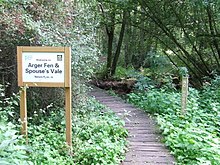|
Arger Fen
Arger Fen is a 49.7-hectare (123-acre) biological Site of Special Scientific Interest (SSSI) south-east of Sudbury in Suffolk, England.[1][2] The site occupies two separate areas. The 17.6-hectare (43-acre) Arger Fen Local Nature Reserve is part of the larger eastern block,[3][4] and contains part of the 21-hectare (52-acre) Tiger Hill Local Nature Reserve,[5][6] along with part of the 110-hectare (270-acre) Arger Fen and Spouse's Vale, a nature reserve managed by the Suffolk Wildlife Trust.[7] The site lies in the Dedham Vale Area of Outstanding Natural Beauty,[8] The site is made up of a mix of woodland and meadow habitats with much of the woodland believed to be ancient in origin.[9] The underlying geology is a mixture of sand and gravel banks and clay soils, producing a mix of habitat types, including wet fen type habitats at lower levels and dry grasslands on acidic soils on hill tops.[9] It is one of only two known areas of ancient woodland in Eastern England which feature wild cherry (Prunus avium).[7][9] Badgers are found on the reserve in a number of active setts.[7][9] Other rare fauna include the hazel dormouse and barbastelle bat.[7] In 2012 the reserve, which has ash trees at least 300 years old, was identified as a site of ash dieback[7][10] and in 2013 it became a research site for Forestry Commission scientists studying genetic resistance to the Chalara fungus which causes the disease.[11] There are onsite car parking facilities as well as two-way marked trails, including areas of board walk.[7] The trust has attempted to encourage the growth of the dormouse population, partly by expanding the area of land it owns at Arger Fen.[12] References
Wikimedia Commons has media related to Arger Fen. |
||||||||||||||||||||

